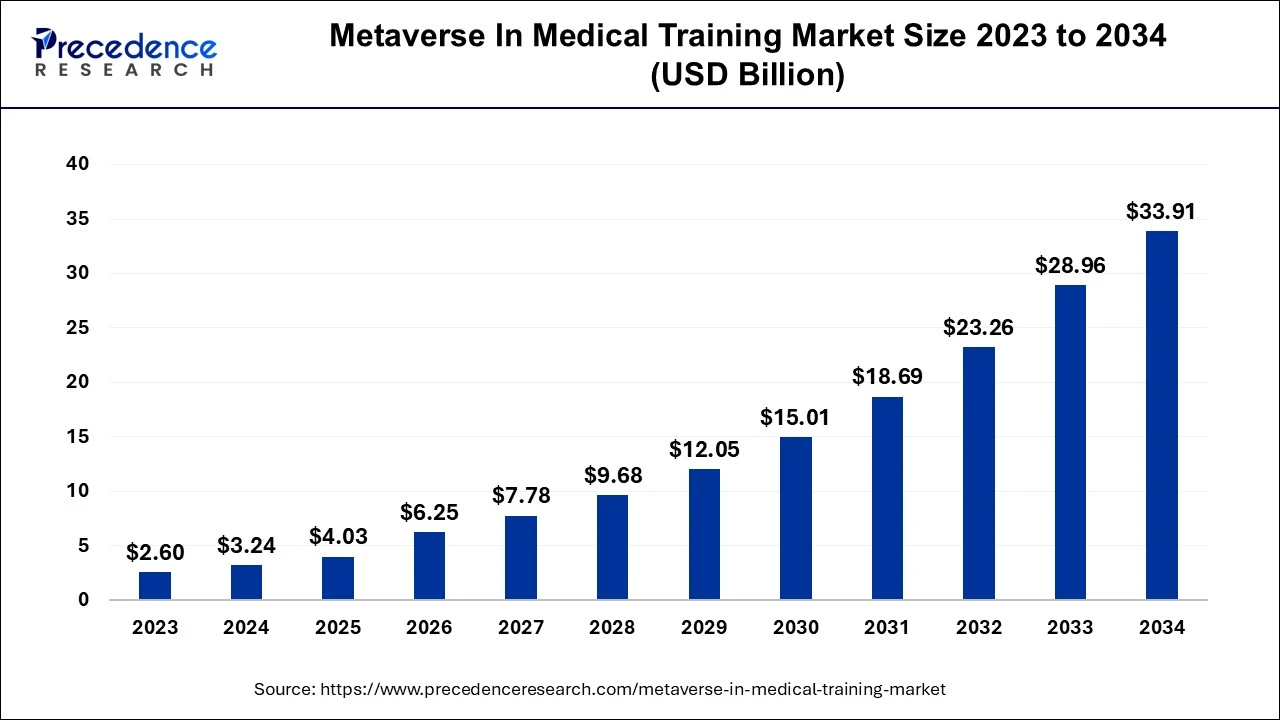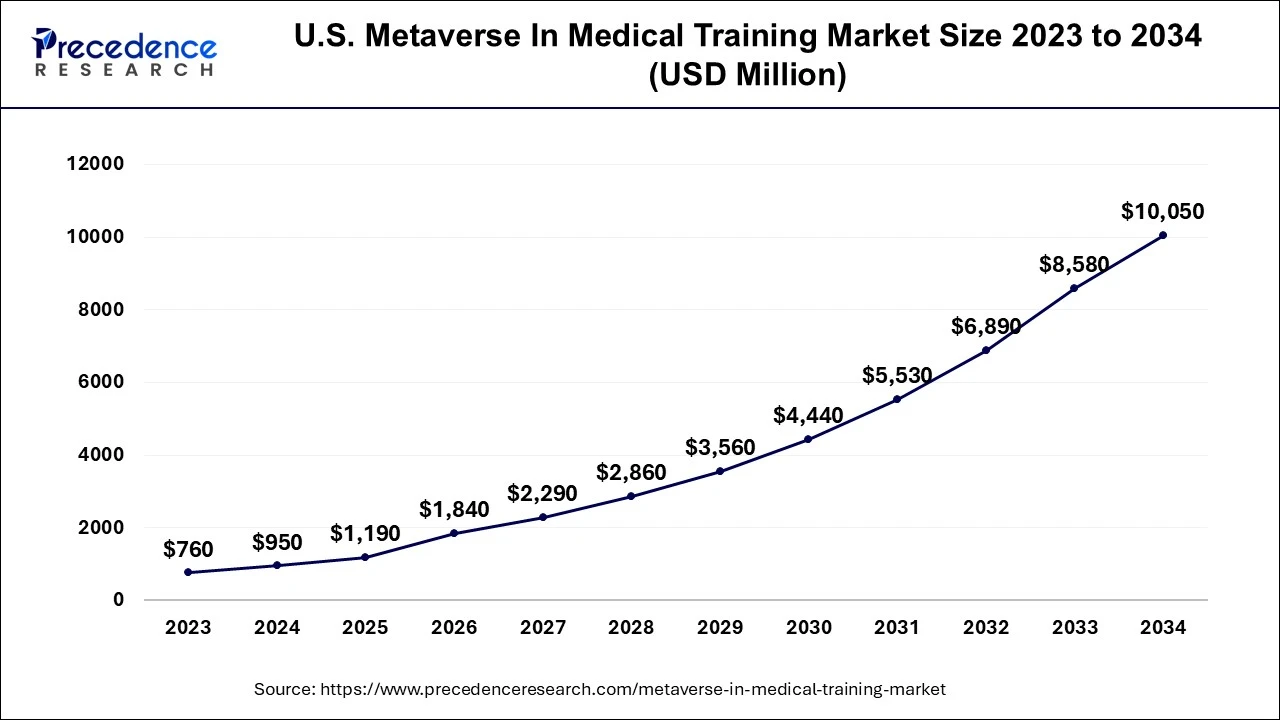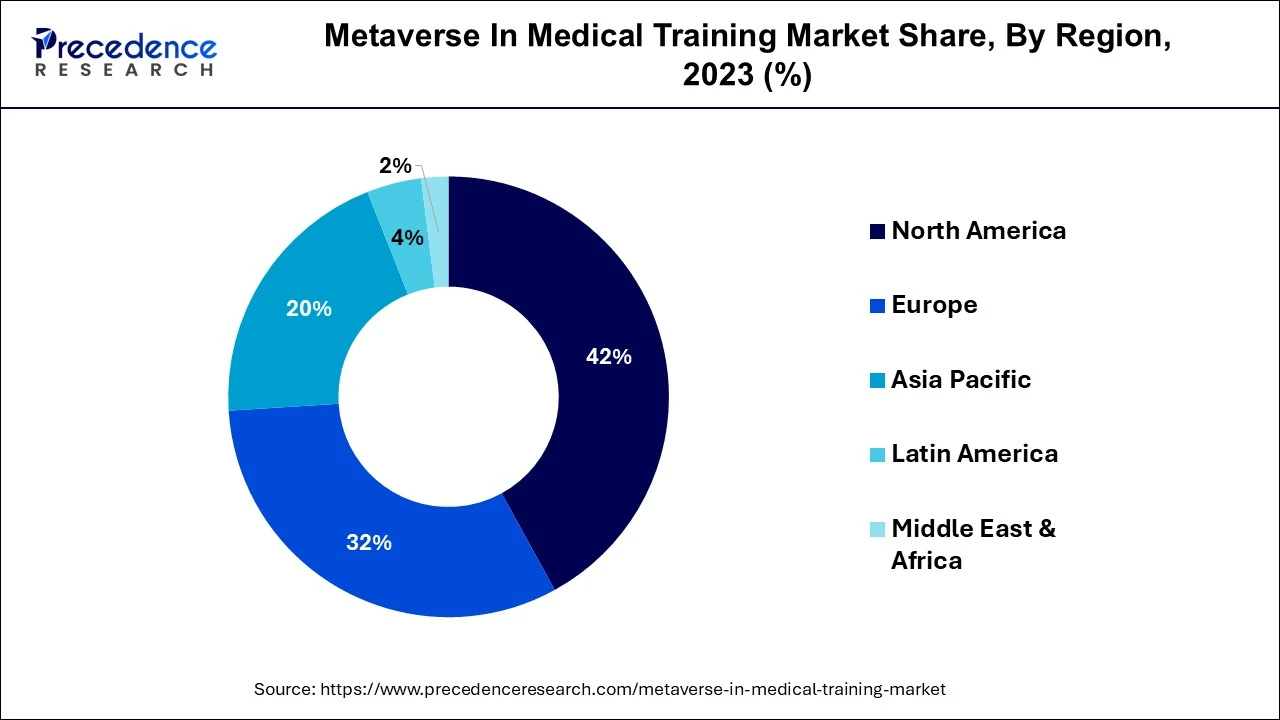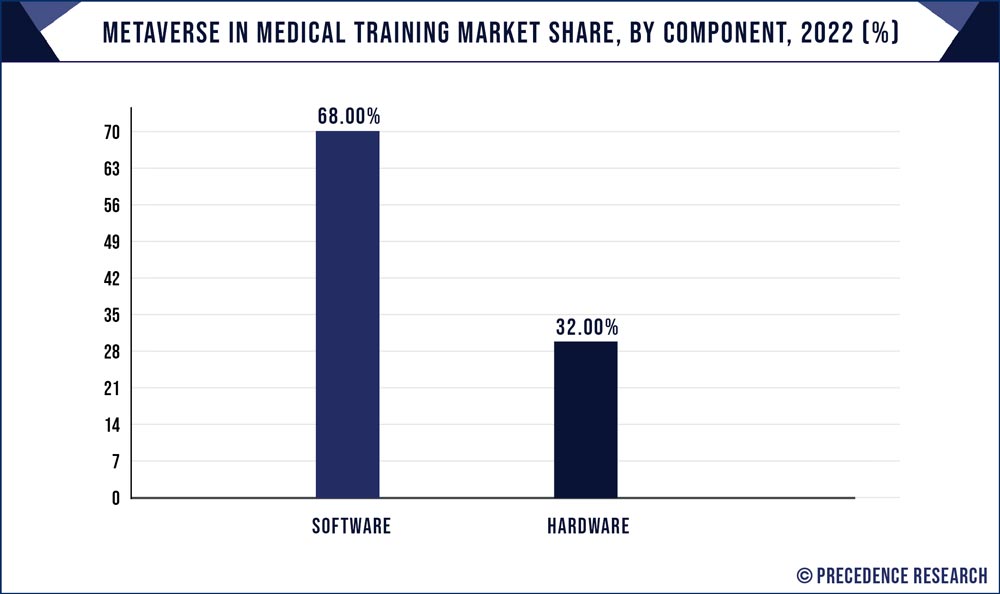December 2024
The global metaverse in medical training market size is estimated at USD 3.24 billion in 2024, grew to USD 4.03 billion in 2025 and is predicted to surpass around USD 33.91 billion by 2034, expanding at a CAGR of 26.47% between 2024 and 2034.
The global metaverse in medical training market size accounted for USD 3.24 billion in 2024 and is anticipated to reach around USD 33.91 billion by 2034, growing at a CAGR of 26.47% between 2024 and 2034.

The U.S. metaverse in medical training market size was estimated at USD 760 million in 2024 and is expected to be worth around USD 10,050 million by 2034, at a CAGR of 26.60 % from 2024 to 2034.

North America has held largest revenue share of 37% in 2023. The North American metaverse in medical training market is characterized by its early adoption and innovation. The region is at the forefront of integrating virtual and augmented reality into medical education, with top medical institutions embracing the technology. There is a trend toward creating comprehensive medical simulations and collaborative platforms that engage medical professionals in immersive learning experiences. The demand for lifelong learning solutions and cutting-edge assessment tools is driving the market, ensuring that healthcare practitioners remain at the forefront of medical advancements.

Asia-Pacific is estimated to observe the fastest expansion. In Asia-Pacific, the metaverse in medical training market is experiencing rapid growth. The market is defined by increasing investment in healthcare technologies and a surge in medical professionals seeking innovative training solutions. This region is witnessing a trend of fostering international collaborations to access and develop metaverse medical training content. The demand for cost-effective, accessible, and engaging lifelong learning opportunities is propelling the market's expansion, making the metaverse a pivotal tool in medical education throughout the Asia-Pacific region.
The metaverse in the medical training market represents a cutting-edge approach to healthcare education. It leverages virtual and augmented reality technologies to create immersive, simulated medical environments. In these digital realms, medical professionals and students can undergo realistic training experiences, including surgeries, patient care, and diagnostic procedures.
The metaverse in medical training is revolutionizing medical education by offering a safe and low-risk environment for honing medical skills, improving decision-making, and enhancing teamwork. This innovative approach enables learners to practice, make mistakes, and learn from them, ultimately leading to more proficient and confident healthcare professionals.
| Report Coverage | Details |
| Market Size in 2024 | USD 3.24 Billion |
| Market Size by 2034 | USD 33.91 Billion |
| Growth Rate from 2024 to 2034 | CAGR of 26.47% |
| Largest Market | North America |
| Base Year | 2023 |
| Forecast Period | 2024 to 2034 |
| Segments Covered | Component, Technology, Devices, End User, and Region |
| Regions Covered | North America, Europe, Asia-Pacific, Latin America, and Middle East & Africa |
Immersive learning experience and interdisciplinary training
The metaverse offers a revolutionary approach to medical training by immersing learners in highly realistic and interactive environments. In these digital realms, medical professionals and students can practice surgical procedures, patient care, and diagnostics with an unparalleled level of realism. This immersive experience allows them to develop critical skills, make mistakes, and learn from them, all without putting real patients at risk. As a result, learners become more proficient and confident, leading to a growing demand for Metaverse-based training solutions.
The metaverse fosters collaboration and interdisciplinary training, enabling professionals from various medical specialties to work together in a shared virtual space. This collaboration promotes a more holistic understanding of healthcare and prepares learners for real-world scenarios where teamwork and comprehensive expertise are crucial. The demand for metaverse training in interdisciplinary healthcare settings is on the rise as institutions seek comprehensive and well-rounded medical education solutions.
Cost of implementation and technical challenges
The metaverse in medical training market faces several challenges that can restrain its demand. One significant restraint is the cost of implementation. Developing and deploying high-quality Metaverse platforms for medical training requires substantial financial investments. This can be a barrier for smaller medical institutions and organizations with limited budgets. Additionally, ensuring that the metaverse content remains accurate and up to date necessitates ongoing expenses, further increasing the financial burden.
Technical challenges also pose a restraint. Developing metaverse platforms that accurately replicate medical procedures and environments while maintaining a seamless and realistic user experience is complex. Implementing the metaverse in medical training necessitates the integration of advanced technologies such as virtual and augmented reality, alongside the development of high-fidelity 3D models.
Overcoming the technical challenges associated with maintaining low-latency interactions and ensuring compatibility across various platforms can be highly demanding. These challenges can slow down the adoption of metaverse-based medical training solutions, limiting their market demand, especially for those with limited technical expertise and resources.
Lifelong learning solutions, data analytics and assessment tools
Lifelong learning solutions in the metaverse for medical training are a key driver of market demand. The ability to offer continuous, accessible, and engaging education opportunities ensures that medical professionals can stay up to date with the latest advancements in healthcare throughout their careers. This lifelong learning aspect attracts medical institutions and professionals seeking to enhance their expertise and adapt to evolving medical practices. As the healthcare industry evolves, the metaverse becomes a dynamic platform for professionals to continually refine their skills and broaden their knowledge.
Data analytics and assessment tools provide invaluable insights and performance tracking within the metaverse. By capturing and analyzing user data, medical educators can assess individual and group progress, identifying areas where further training is needed. This data-driven approach not only optimizes learning but also ensures that medical professionals are competent and confident in their skills. The demand for such assessment tools grows as institutions seek effective ways to monitor and enhance the competence of their medical workforce, making the metaverse an increasingly vital component of medical training and development.
According to the component, the disposables segment held 68% revenue share in 2023. Hardware in the metaverse in medical training market refers to the physical devices and equipment necessary for a seamless immersive experience. This includes VR headsets, haptic feedback devices, and advanced computer systems. The trend in hardware is toward more compact, lightweight, and user-friendly devices that offer high-resolution visuals and realistic haptic feedback, improving the overall quality of the training experience.

The reusable segment is anticipated to expand at a significant CAGR of 26.3% during the projected period. Software pertains to the applications, platforms, and content that create virtual medical training environments. These software solutions are becoming increasingly sophisticated, incorporating AI-driven scenarios, real-time collaboration, and responsive simulations. The trend in software development is to deliver content that is not only highly immersive but also easily customizable, ensuring a tailored learning experience for medical professionals.
The Virtual Reality (VR) segment held the largest market share of 48% in 2023. Virtual Reality (VR) in the metaverse for medical training market involves the use of immersive digital environments to simulate medical scenarios. VR headsets and controllers provide a realistic experience, enabling trainees to practice procedures and make decisions in a safe, simulated environment. The trend in VR for medical training is the integration of haptic feedback and highly accurate anatomical models, enhancing the tactile and visual aspects of learning.
The Augmented Reality (AR) segment is projected to grow at the fastest rate over the projected period. Augmented reality (AR) in the metaverse for medical training market overlays digital information on the real world. AR applications can be used in medical training by providing real-time guidance during procedures. The trend in AR includes hands-free AR glasses and advanced image recognition technology, enabling seamless integration of digital information into the physical world, offering on-the-job support for medical professionals.
In 2023, the VR headsets segment had the highest market share of 46% on the basis of the end user. VR headsets are immersive devices that transport users to a computer-generated environment. In the metaverse for medical training, VR headsets provide a fully immersive experience for medical professionals. They're used for surgical simulations, patient interactions, and diagnostic training, offering a realistic, hands-on learning environment. The trend in this space includes the development of more comfortable, high-resolution VR headsets, making training more engaging and effective.
The mixed reality platforms segment is anticipated to expand at the fastest rate over the projected period. Mixed reality platforms combine elements of both the physical and virtual worlds. In medical training, they allow for the overlay of digital information on real-life scenarios. This trend includes the integration of holographic medical data into physical environments, creating highly interactive and context-rich training experiences, with real-time feedback and guidance for trainees. These platforms offer a dynamic approach to medical training within the metaverse.
In 2023, the medical schools and universities segment had the highest market share of 41% on the basis of the end user. Medical schools and universities are primary end users of the metaverse in medical training. They utilize these virtual environments to provide students with hands-on, immersive learning experiences. The trend in this sector involves expanding the use of the metaverse for medical curriculum, allowing students to practice surgeries, patient care, and diagnostics within a safe digital realm. Additionally, institutions are increasingly incorporating the metaverse into continuing medical education programs to ensure that graduates and healthcare professionals remain up to date with the latest developments in the field.
The hospitals and healthcare institutions segment is anticipated to expand at the fastest rate over the projected period. Hospitals and healthcare institutions leverage metaverse to offer ongoing training and professional development to their staff. The trend is toward creating customized metaverse platforms that address specific skill gaps and support interdisciplinary teamwork.
Hospitals and healthcare institutions increasingly appreciate the metaverse's role in providing a secure and immersive training environment for their healthcare professionals. This environment enhances the expertise of medical staff, ultimately leading to improved patient outcomes and a reduction in medical errors. As the effectiveness of the Metaverse in medical training becomes more evident, hospitals and healthcare institutions are poised to further embrace and expand their adoption of this innovative technology.
Segments Covered in the Report
By Component
By Technology
By Devices
By End User
By Geography
For inquiries regarding discounts, bulk purchases, or customization requests, please contact us at sales@precedenceresearch.com
No cookie-cutter, only authentic analysis – take the 1st step to become a Precedence Research client
December 2024
February 2025
October 2024
October 2024